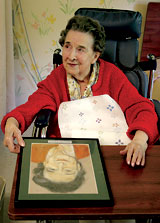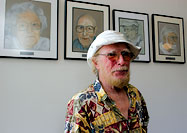“I look like a booger! That is good … from what you had to start on.”
— Beatrice Pace on Bob Collins’ portrait of her
 |
If every picture really does tell a story, then Bob Collins aims to make sure Saluda’s little-known stories wind up in pictures.
“The people in this community are amazing,” said Collins, who lives in nearby Hendersonville, during a recent interview at the Saluda Community Library. He traces his fascination with the place to a visit a few years ago, when he had an unexpected encounter with a local. “I was trying to get to a funeral way out in the woods here, and I stopped to ask this old guy for directions,” he recalled. “He told us how to get there — then rode the whole way there behind us on a motorcycle. He was so kind; he wanted to make sure we made it where we were going.”
So Collins came back and got to know the kindly Albert “Abe” Thomas, a Saluda old-timer who lived without most modern conveniences. “He said things like, ‘I want a woman, but she’s got to listen to me,'” Collins says of Thomas, who died in 2003. “He was living with pussycats all over the place, and he showed me about 10 of those motorcycles he ran over the years.” Thomas loved ice-cream cones, making regular runs to a shop downtown to satisfy his sweet tooth.
Collins, a sometime journalist, was hooked. He saw a wealth of stories just waiting to be mined in Saluda. Still, he wanted to be careful about how they were told, wanting to do justice to the history without invading anybody’s privacy. After a newspaper article highlighted Thomas’ rustic lifestyle, notes Collins, some “do-gooders” arranged for the mountain man to take up residence in a nursing home. There, he lost his spirit and died within a matter of months.

photos by Roxanne Turpen
|
Eventually Collins, a veteran photographer and artist, settled on two local history projects. One would be a booklet titled Hidden Historic Treasures. Having gone through several drafts, the work is now almost complete. Collins describes it as an attempt “to put the old structures that have been overgrown and forgotten all these years together with the people who once inhabited them.” (The publication will be available at selected area bookstores, or can be ordered at altersyn@bellsouth.net.)
Collins also decided to produce a series of portraits of Saluda’s most venerable personalities, starting with Thomas. The pastel drawing, which depicts him in his trademark overalls and cap, bears this inscription: “It is best to leave a wild flower lay — for it won’t live long in a vase.”
A ramblin’ man
Reclining in a low chair at the library, Collins sports a Hawaiian-style shirt, blue jeans, cowboy boots and a white fisherman’s hat that’s buttoned up on one side; his long legs jut out before him. He speaks in a warm baritone with an accent that’s hard to place, punctuating his words with frequent chuckles. He’s got a bit of the vagabond about him, or maybe the swashbuckler (think Dennis Hopper’s frenetic photographer in Apocalypse Now).
How Collins came to settle in Western North Carolina is a story in itself. He was born in Rahway, N.J.; his father was a theatrical-union organizer and his mother worked in a burlesque joint. In college at Rutgers University, a prescient adviser told him, “You’re going to be a jack-of-all-trades; your curiosity is going to take you all over the place.”
And so it did; from there, Collins roamed far and wide and wore many hats. “I studied at two art schools; I’ve been a Baptist minister assistant; I’ve been a cowboy who ran a horse ranch in California,” he recounts. And then there were the newspaper gigs, the political agitating and the international travel. “I was in Nicaragua when Daniel Ortega was president,” he remembers (recently re-elected to the Nicaraguan presidency, Ortega held the same office in the 1980s as part of the Sandinista government). “I was in Guatemala when a coup took place; I was in Colombia when Pablo Escobar escaped. Mostly I lived in Jersey and Florida.”
After decades of living on and off the road, Collins settled in North Carolina in the 1990s. And though he plans to live out his days here, his work is far from done.
The Kingdom of Saluda
“The old kings had portrait artists to document them,” says Collins. “So I decided to become the town’s portrait artist.” Last year, he approached local officials and proposed a “Kingdom of Saluda” project, as he calls it — a series of portraits that would pay homage to the community’s notable seniors.
“They said, ‘Go for it,'” he recounts. “Now they’re suggesting people for me to paint.” This summer, the town’s library cleared a wall where Collins can hang the portraits as he completes them. “It’s a quick introduction to important people of the area,” librarian Bob McCall says of the collection. “It’s like instant history.”
So far, Collins has done five. “I thought I was only going to do just about 10, but I might stay with this,” he says.
After Abe Thomas, Collins set his sights on Charlie Ward, who runs Ward’s Grill, the Main Street fixture his parents founded back in 1941. Next, the artist painted Lola Ward, Charlie’s 102-year-old mother, who’s still alive today. Then there was Robert Pace, who runs the M.A. Pace Store, another Main Street mainstay.



Before you comment
The comments section is here to provide a platform for civil dialogue on the issues we face together as a local community. Xpress is committed to offering this platform for all voices, but when the tone of the discussion gets nasty or strays off topic, we believe many people choose not to participate. Xpress editors are determined to moderate comments to ensure a constructive interchange is maintained. All comments judged not to be in keeping with the spirit of civil discourse will be removed and repeat violators will be banned. See here for our terms of service. Thank you for being part of this effort to promote respectful discussion.